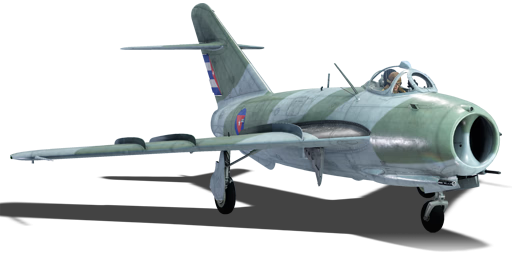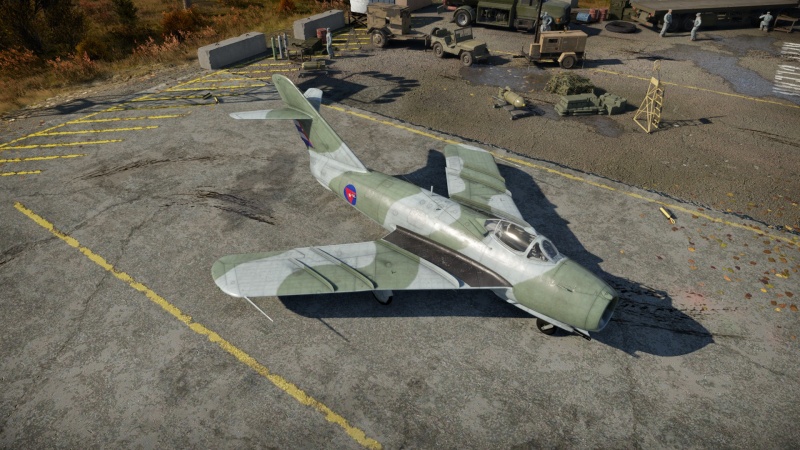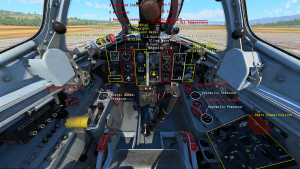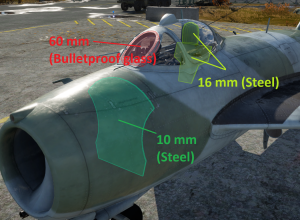MiG-17AS
| This page is about the gift Soviet jet fighter MiG-17AS. For other versions, see MiG-17 (Family). |
Contents
Description
During 1964, Cuba became one of the first export customers of the MiG-17 aircraft outside the Warsaw Pact, having purchased the MiG-17AS variant to replace its aging MiG-15bis fleet in the frontline fighter role. The MiG-17AS, in addition to the more reliable engine, had the required wiring to mount and use the R-3S air-to-air missile. The aircraft would serve a long life with the Cuban Air Force before being phased out of service in favour of MiG-23s during the 1980s. The MiG-17AS in Cuban service is most famous for the Homestead incident; on October 5, 1969, Cuban MiG-17AS #232 was flown by Lieutenant Eduardo Guerra Jimenez to defect to the United States, landing it in Homestead AFB, Florida, and sparking major controversy and reforms about American security almost instantly, as President Lyndon B. Johnson's Boeing 707 "Air Force One" was at the time also at the airbase used for the defection, and as the Cuban pilot's intentions were not known until after he landed (undetected). Had his intentions been different, he could have easily not only destroyed Air Force One on the ground, but started a surprise attack on US soil.
The MiG-17AS was introduced in Update 1.91 "Night Vision" as a pack premium in the Gaijin store. Being a MiG-17 airframe, it has the same advantages and disadvantages of its tech tree brother, the MiG-17. The primary difference is that the MiG-17AS has access to the R-3S air-to-air missile, which the tech tree variant does not get. All in all, the MiG-17AS is an interesting premium, mostly reserved for collectors, as it does not have a major advantage over the tech tree equivalent,
The MiG-17AS was removed from the Gaijin store after the 2022 May sale. The MiG-17AS has since been made temporarily available as a collector aircraft, returning briefly for certain historical events for purchase in-game using Golden Eagles ![]() . The aircraft would first return (temporarily) for purchase during the 2023 "Russian Air Force Day" mini-event.
. The aircraft would first return (temporarily) for purchase during the 2023 "Russian Air Force Day" mini-event.
General info
Flight performance
The MiG-17AS is powered by the Klimov VK-1 jet engine, the same as the engine found on the MiG-17. This engine performs well at higher altitudes, and affords this vehicle much better high-altitude flight characteristics than its American counterpart, the F-86. This also means that the MiG-17 performs much better in vertical manoeuvres than many other aircraft. The engine also gives this vehicle very good energy retention and a high climb rate. At high speeds (>900 km/h), the aircraft experiences compression and loses roll and pitch authority.
| Characteristics | Max Speed (km/h at 2,000 m) |
Max altitude (metres) |
Turn time (seconds) |
Rate of climb (metres/second) |
Take-off run (metres) | |||
|---|---|---|---|---|---|---|---|---|
| AB | RB | AB | RB | AB | RB | |||
| Stock | 1,097 | 1,061 | 15500 | 22.2 | 23.2 | 41.2 | 39.1 | 475 |
| Upgraded | 1,128 | 1,114 | 21.2 | 21.5 | 59.9 | 50.0 | ||
Details
| Features | |||||
|---|---|---|---|---|---|
| Combat flaps | Take-off flaps | Landing flaps | Air brakes | Arrestor gear | Drogue chute |
| X | ✓ | ✓ | ✓ | X | X |
| Limits | ||||||
|---|---|---|---|---|---|---|
| Wings (km/h) | Gear (km/h) | Flaps (km/h) | Max Static G | |||
| Combat | Take-off | Landing | + | - | ||
| 1,093 | 450 | N/A | 598 | 450 | ~12 | ~5 |
| Optimal velocities (km/h) | |||
|---|---|---|---|
| Ailerons | Rudder | Elevators | Radiator |
| < 600 | < 700 | < 750 | N/A |
Engine performance
| Engine | Aircraft mass | |||||
|---|---|---|---|---|---|---|
| Engine name | Number | Basic mass | Wing loading (full fuel) | |||
| Klimov VK-1 | 1 | 3,958 kg | 227 kg/m2 | |||
| Engine characteristics | Mass with fuel (no weapons load) | Max Takeoff Weight | ||||
| Weight (each) | Type | 8m fuel | 20m fuel | 29m fuel | ||
| 892 kg | Centrifugal-flow turbojet | 4,310 kg | 4,755 kg | 5,130 kg | 5,485 kg | |
| Maximum engine thrust @ 0 m (RB/SB) | Thrust to weight ratio @ 0 m (100%) | |||||
| Condition | 100% | WEP | 8m fuel | 20m fuel | 29m fuel | MTOW |
| Stationary | 2,450 kgf | N/A | 0.57 | 0.52 | 0.48 | 0.45 |
| Optimal | 2,450 kgf (0 km/h) |
N/A | 0.57 | 0.52 | 0.48 | 0.45 |
Survivability and armour
The MiG-17AS armour around the pilot is a bit more substantial than that seen on F-86 Sabres. With a large 10 mm steel plate in the nose, this armour protects both the pilot and the fuel tank from any glancing frontal shots from going through and causing damage. A 60 mm bullet proof glass is also present in front of the pilot, which may also offer some ballistic protection against machine gun rounds. However, the glass and steel armour are not substantial enough to take a head-on attack from a similar aircraft, so don't use these as a safety net from head-on attacks. 16 mm steel plates cover the pilot's seat, which will protect the pilot against any glancing shots approaching from the rear, but it does not protect the fuel tank.
The MiG-17AS structure overall is minimal, with a lot of empty spaces in the fuselage and tail, but the control surfaces all over are still vulnerable to being cut and driving the MiG-17AS out of control. Although there are two self-sealing fuel tanks on the MiG-17AS, the largest one is seated right behind the pilot and so can be prone to being hit. This means an enemy that misses an attempt at a pilot snipe can still have a chance of hitting the fuel tank and igniting it, causing crippling damages to the overall MiG-17AS structure.
Like the MiG-15 before it, if the tail vertical stabilizer gets knocked off the plane, so are the elevators, leaving the aircraft helpless if not already determined a victory by the score system to the offending enemy.
It is important to note that the MiG-17 does not take damage well. Damage to the fuselage, even if minimal, will significantly hamper performance in the speed and energy retention department. Any damage to the wings will cause the aircraft to roll to one side, impairing its ability to properly dogfight its opponents. Damage to the engine is also quite fatal. Though still flyable after light damage, it is recommended to return to base if damaged, as the aircraft loses its ability to dogfight completely.
Modifications and economy
Armaments
Offensive armament
The MiG-17AS is armed with:
- 1 x 37 mm N-37D cannon, chin-mounted (40 rpg)
- 2 x 23 mm NR-23 cannons, chin-mounted (80 rpg = 160 total)
The Nudelman N-37D was a 37 mm autocannon which replaced the Nudelman-Suranov NS-37 autocannons. The N-37D was 30% lighter than the NS-37, but to lighten the load, a sacrifice was made causing a 23% drop in muzzle velocity in comparison. Even with the loss of muzzle velocity, this autocannon can still fire at 400 rounds per minute which equates to just over six per second, emptying the belt in just over 7 seconds if the firing button is continuously held and the gun does not jam. The continuous fire of this weapon should not be attempted as only one or two rounds is enough to take down the largest of aircraft, though a dodging fighter may take a few more rounds before one connects.
The Nudelman-Rikhter NR-23 was a 23 mm autocannon which was widely used on many Soviet aircraft. The NR-23 has a faster muzzle velocity over the N-37D by 200 m/s, firing them at the same time will not result in them landing in the same place as the N-37D will begin to drop sooner. Firing at around 900 rounds per minute, the NR-23 can unload a good amount of ammunition downrange, however, with a limited supply of only 80 rounds per gun, it is best to fire in small bursts when the pilot has a good gun solution. Firing in "hopes" to hit the target will result in many missed and wasted shots and may very well cause the MiG-17AS to go dry just when those rounds are needed the most.
Though the combination of the aforementioned cannons can pack quite a punch, the low accuracy, low muzzle velocity, low ammo count, and odd placement makes them quite difficult to aim. It is recommended to set the weapon convergence to 400 m since the guns will not reliably reach any farther than that. Some may also find it helpful to toggle on vertical convergence, due to the high drop these autocannons have. Currently, the recommended ammo belts are armoured targets for both of the cannons, since the high explosive shells lack damage.
Suspended armament
The MiG-17AS can be outfitted with the following ordnance:
- Without load
- 2 x 250 kg OFAB-250sv bombs (500 kg total)
- 2 x S-21 unguided rockets
- 2 x R-3S air-to-air missiles
Though built as a fighter-interceptor the MiG-17AS has the suspended ordnance option to actually take on a multi-role function. The MiG-17AS can function also as a fighter-bomber, fighter-attacker as well as a fighter-interceptor. To fulfil the bomber role, the MiG can be outfitted with two 250 kg bombs, though not enough to put a dent in an enemy base, these bombs are a great option for strategic bombing of vehicles or anti-aircraft artillery which may be a bit more spread out. These one-off or mobile targets are difficult for the higher up bombers to hit, but a fast and nimble strategic fighter-bomber can get in low and deliver the ordnance on to the target more efficiently.
As for the fighter-attacker role, the S-21 unguided rockets come into play. These unguided rockets are best used against ground-based tanks or high altitude bombers. Since the rockets are unguided, they work best against slow-moving targets and firing at a relatively short-range to endure positive contact either crippling the enemy vehicle or destroying it. The S-21 is a fire-and-forget rocket in that once it takes off, there is nothing more to do than let it reach its destination. At this point, the fighter can take evasive action or set up for another run if there are any rockets available to shoot.
For fast-paced air-to-air combat, the MiG-17AS can be outfitted with two R-3S missiles (reversed engineered AIM-9 Sidewinder also known as the Vympel K-13 or NATO AA-2 "Atoll"). This missile works best when flying behind the target aircraft to allow the system enough time to gain a lock. Once the lock is achieved, the missile can be fired. It is best to fire between 1 and 1.5 km from the target to allow for the least amount of reaction time and potential for evasive action on the enemy aircraft's part. Firing a missile from a greater distance is possible, however, the more that the enemy fighter can react to the missile launch, the better the odds are that they will be successful in evading the missile. If the missile is evaded, all is not lost, many times the enemy fighter had to perform several energy bleeding manoeuvres to evade the missile which may ultimately set them up for the MiG-17AS pilot to close in and eliminate the target with their 37 mm and 23 mm autocannons.
Usage in battles
Against enemy aircraft
The MiG-17AS has much better high-altitude flight characteristics most planes at its rank, so it is best played in higher-altitude dogfights. Nearer to sea level, the competition will have better engine performance.
This vehicle performs much better in vertical manoeuvres than many other aircraft, and such manoeuvres may be employed to cause an enemy aircraft to stall, giving the player an easy kill. But make sure that there are no other enemies nearby before attempting a low-speed stall manoeuvre.
The engine also gives this vehicle very good energy retention and a high climb rate. However, the plane begins to compress at high speeds, and aiming may become difficult. To avoid compression of the control surfaces, it is advisable to put the aircraft in a slight climb (~10°) when at higher speeds (>700 km/h ias) in order to build up an energy advantage while remaining manouverable.
So, this plane is well-suited for medium-speed dogfights, where it can utilise its energy retention and good turn rate against enemy aircraft. In addition, luring enemies to slow speeds will allow the MiG-17AS's air-to-air missiles to better track and destroy them. (In practically all other cases, the poor-tracking missiles will struggle to keep up with a fast-moving, turning enemy.)
As for cannon armament, the MiG-17AS has three high-calibre cannons. This may sound perfect at first glance, but the armament setup on this plane does create difficulties on further consideration. First of all, these cannons are all slow-firing, and it is not uncommon that a fast-moving enemy will slip between cannon shells and avoid destruction. Also, the shells have a fairly low muzzle velocity compared to that of other jets at this rank, and have quite a noticeable drop. Combined with the slow firing speed, this makes aiming difficult at the best of times, and extremely challenging at ranges over 400 m. But as if all of that wasn't enough, the cannons are mounted below the nose of the plane, making aim difficult for players inexperienced in flying with this gun positioning. Furthermore, all three cannons have quite low ammo counts, so trigger discipline is key. All in all, this vehicle's guns are certainly not its strong point, but keep in mind that the aircraft's admirable flight characteristics can more than make up for this weakness: when the enemy is stalled out in front of this aircraft, its guns are more than enough to guarantee the kill.
Against ground targets
The MiG-17AS has the option to mount 2 x 250 kg bombs. However, these bombs considerably harm the vehicle's flight performance, and have quite low destructive power. Using them against armoured ground targets is often difficult.
In most cases, a better option is to use the 2 x S-21 air-to-ground rockets available to this aircraft. These each contain a very good 9.95 kg of TNT, and may be fired separately. They also have quite respectable penetration and will be able to penetrate the roof armour of many of the tanks that this vehicle might face in ground RB. They also have a decent velocity and are easier to aim than bombs.
Although the MiG-17AS has some ground attack capabilities, the MiG-17 is by no means a viable CAS aircraft and it is recommended to use it as an air-superiority fighter rather than ground attack.
Pros and cons
Pros:
- Very hard-hitting cannons
- Good manoeuvrability at low to moderate speeds
- Mounts two air-to-air missiles
- Better high-speed manoeuvrability than the MiG-15
- Doesn't rip its wings easily
- Good top speed, especially in a dive
- Flaps are very effective in low-speed fights
Cons:
- Slow roll rate at high speeds
- Missiles are short-range
- Poor visibility in simulator: T-tail, gunsight and thick canopy frames create blind spots towards front and rear
- Armament difficult to use (low velocities, low ammo and two different trajectories)
- Guns tend to spark a lot (the N-37 in particular), especially with stock belts
- Tail hangs very close to the ground. Along with the pelvic fin, this can make takeoff trickier if the pilot is careless.
- Engine will begin to overheat when flying above 96% throttle, though rarely gets to dangerous levels if managed correctly
History
The Korean War showed that the MiG-15 and MiG-15 bis fighters were able to battle any aerial opponent at least on equal terms. The MiG-17 was a further development of the MiG-15 design that had proven itself so well. It was decided to increase the aircraft's speed by increasing the sweep of the wing and the fuselage being lengthened to maintain the centre of gravity. The MiG-15 and MiG-17 show almost no differences at first glance. The prototype of the MiG-17 was even called the MiG-15bis45. However, only the frontal parts of the fuselage are the same, from the air intake to the wing, if you don't count the landing headlight that had been moved to the left-wing and some minor details.
These aircraft are different in every other way. It is easy to see the main differences when you look from above. By comparing the side profiles, you can see that in addition to the difference in fuselage length there are differences in the tail fin and an additional ventral fin which allows you to immediately tell the MiG-17 apart from the MiG-15. The upper part of the fins and the rudders of the aircraft are different, the juncture between the fin and the stabilizer fin also differs, but this can only be seen close up. The wing sweep of the stabilizer fin was also increased and there were also changes to elevators. The air brakes also differ in shape and size. The depth of the housing was decreased, so a cigar-shaped cowl was created to hide the cylinder. There were very significant changes to the wing. Apart from an increased wing sweep, a leading-edge break appeared and the tips became rounder, which helps differentiate the aircraft when looking at them from above or below. While the Mig-15 had two aerodynamic ridges on the top surface of its wings, the MiG-17 had three.
The change in the shape of the wing led to appropriate changes in the construction of the flaps. The new geometry of the main landing gear legs required for the cover to be altered. The structure of the canopy also saw some changes. However, the first versions of the MiG-17 had the same canopies as the MiG-15 bis. Apart from changes to the design of the canopy framing (which is not actually that noticeable from afar), a rear-view mirror was introduced that would allow the aircraft to be recognized from further away. There were no significant changes to the cockpit. Overall, the MiG-17 looks even more aesthetically pleasing and streamlined than its predecessor.
Media
- Skins
- Skins and camouflages for the MiG-17AS from live.warthunder.com.
- "MiG-17AS Kinel-Cherkassk Aviation Training Center" skin in the Gaijin Market
- Videos
See also
- Related development
- Mikoyan-Gurevich MiG-15
- Mikoyan-Gurevich MiG-17
- Shenyang F-5
- Aircraft of comparable role, configuration and era
- Dassault Super Mystere
- Hawker Hunter
- North American F-86 Sabre
External links
- Official data sheet - more details about the performance
- [Wikipedia] Mikoyan-Gurevich MiG-17
- [History Net] MiG-17 produced north Vietnam's first jet to air victories
- [Ruben Urribarres] The MiG-17 Fresco in Cuba
| Mikoyan-Gurevich Design Bureau (Микоя́н и Гуре́вич Опытное конструкторское бюро) | |
|---|---|
| Fighters | MiG-3-15 · MiG-3-15 (BK) · MiG-3-34 |
| I-225 | |
| Jet fighters | MiG-9 · MiG-9 (l) |
| MiG-15 · MiG-15bis · MiG-15bis ISh | |
| MiG-17 | |
| MiG-19PT | |
| MiG-21F-13 · MiG-21PFM · MiG-21S (R-13-300) · MiG-21SMT · MiG-21bis | |
| MiG-23M · MiG-23ML · MiG-23MLD | |
| MiG-27M · MiG-27K | |
| MiG-29 · MiG-29SMT | |
| Export/Licensed | ␗MiG-9 · ␗MiG-9 (l) |
| ◊MiG-15bis · ◔MiG-15bis · J-2* | |
| MiG-17AS · ◔MiG-17PF · J-4* · Shenyang F-5* | |
| ◊MiG-19S · J-6A* | |
| ◄MiG-21 SPS-K · ◊MiG-21MF · ◔MiG-21MF · ▄MiG-21bis · ◔MiG-21bis-SAU · ◊MiG-21bis-SAU · ◊MiG-21 "Lazur-M" · ▄MiG-21 Bison · J-7II** | |
| ◊MiG-23BN · ◊MiG-23MF · ◔MiG-23MF · ◊MiG-23MLA | |
| ◔MiG-29 · ◊MiG-29 · ◄MiG-29G | |
| *Licensed and domesticated with Chinese designations. | |
| **Unlicensed, reverse-engineered and domesticated with Chinese designations. | |
| See Also | Shenyang · Chengdu |
| USSR jet aircraft | |
|---|---|
| Bereznyak-Isayev | BI |
| Yakovlev | Yak-15 · Yak-15P · Yak-17 · Yak-23 · Yak-28B · Yak-30D · Yak-38 · Yak-38M · Yak-141 |
| Mikoyan-Gurevich | MiG-9 · MiG-9 (l) · MiG-15 · MiG-15bis · MiG-15bis ISh · MiG-17 · MiG-17AS · MiG-19PT |
| MiG-21F-13 · MiG-21PFM · MiG-21S (R-13-300) · MiG-21SMT · MiG-21bis | |
| MiG-23M · MiG-23ML · MiG-23MLD · MiG-27M · MiG-27K | |
| MiG-29 · MiG-29SMT | |
| Lavochkin | La-174 · La-15 · La-200 |
| Sukhoi | Su-9 · Su-11 |
| Su-7B · Su-7BKL · Su-7BMK · Su-17M2 · Su-17M4 · Su-22M3 | |
| Su-24M | |
| Su-25 · Su-25BM · Su-25K · Su-25T · Su-25SM3 · Su-39 | |
| Su-27 · Su-27SM | |
| Ilyushin | IL-28 · IL-28Sh |
| Tupolev | Tu-14T |
| USSR premium aircraft | |
|---|---|
| Fighters | Krasnolutsky's I-15bis · I-16 type 28 · Zhukovsky's I-153-M62 · I-153P · I-180S · I-301 · ITP (M-1) |
| LaGG-3-4 · LaGG-3-23 · LaGG-3-34 · Dolgushin's La-7 · La-11 | |
| Eremin's Yak-3(e) · Yak-3 (VK-107) · Yak-3T · Golovachev's Yak-9M | |
| ▂P-39K-1 · ▂Pokryshkin's P-39N-0 · ▂P-39Q-15 · ▂P-40E-1 · ▂P-47D-27 · ▂P-63A-5 · ▂P-63A-10 · ▂P-63C-5 | |
| ▂Hurricane Mk IIB · ▂Spitfire Mk IXc · ▂Fw 190 D-9 | |
| Twin-engine fighters | I-29 |
| Jet fighters | Su-11 · MiG-15bis ISh · MiG-17AS · MiG-21S (R-13-300) · MiG-23ML |
| Strike aircraft | IL-2M "Avenger" · IL-2 M-82 · IL-8 (1944) · Su-6 · Tandem MAI · TIS MA · Su-8 · Tu-1 |
| Yak-38 · Su-7BMK · Su-25K · Su-39 | |
| Bombers | Po-2M · Be-6 · MBR-2-M-34 · Pe-2-205 · TB-3M-17-32 |
| ▂PBY-5A Catalina · ▂Hampden TB Mk I · ▂A-20G-30 · ▂B-25J-30 | |







